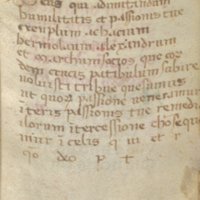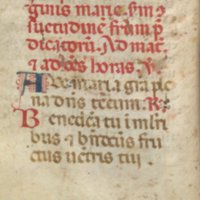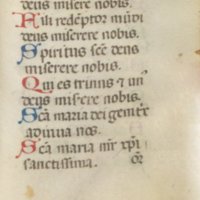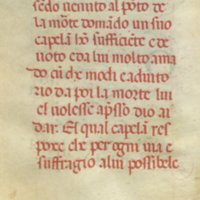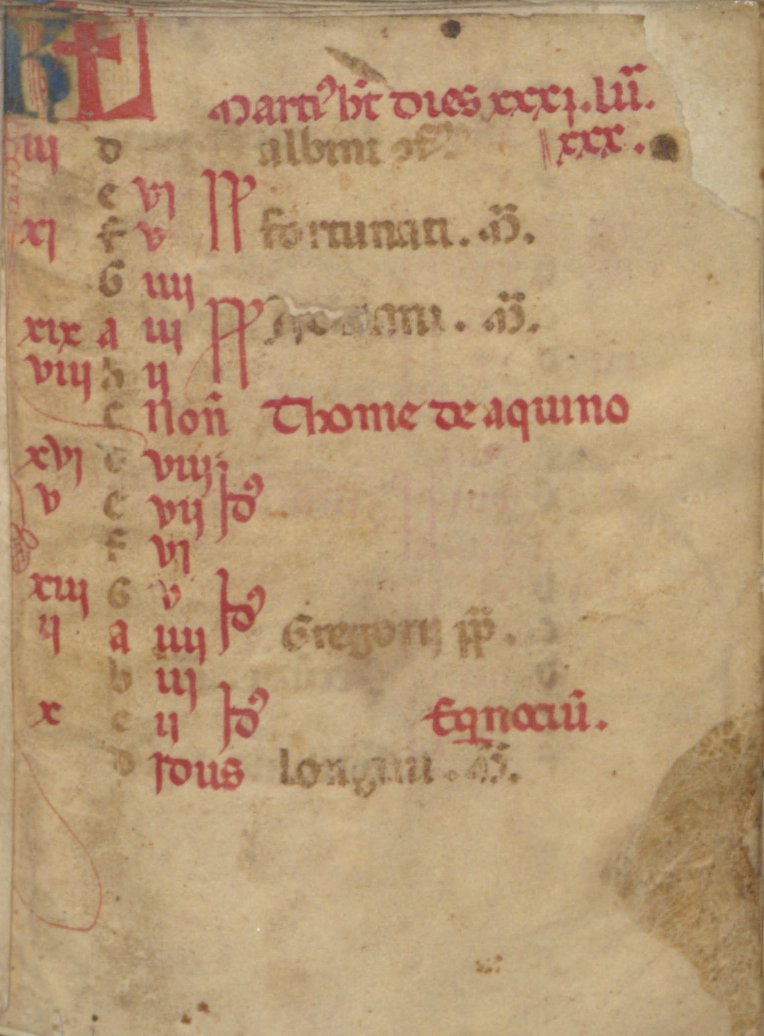
Book of hours (use of Rome) : with added prayers…
Information About This Item
Creator
Catholic Church.
Title
Book of hours (use of Rome) : with added prayers and Marian litanies.
Date
approximately 1470 to approximately 1490.
Description
A nearly complete fifteenth-century Book of Hours from the Convent of Santi Giovanni e Paolo in Venice. In addition to the Hours of the Virgin, Penitential Psalms, and Office of the Dead, the manuscript contains unusual Marian litanies.
Fols. 109v: Pars prima. Graded kalendar beginning with March. Dominican saints Dominic and Peter Martyr in red, alongside the Venetian saints George and Mark, as well as SS. John and Paul. Curious are Pelagia the Courtesan and Sabba -- Fol. 10r: Latin prayer, inc. "Deus qui ad imitandum," added to an orginally blank folio -- Fols. 10v-122v: Officium Beate Marie, of Dominican Use; fol. 10v Matins, 35r Lauds, 63 Prime, 72r Terce, 79r Sext, 85v none, 93 Vespers, 108r Compline -- Fol. 11: Blank, a replacement for a missing illuminated folio ; fols. 119r-122v: Seasonal instructions -- Fols. 123r-223v: Office of the Dead, for Dominican use -- Fols. 224r-244v: Penitential psalms -- Fols. 245r-257v: Kyrie and litany with ancillary texts -- Fols. 258r-261v: Prayers -- Fols. 261v-267r: Shorter Office of the Cross -- Fols. 267r-270v: Added texts, including indulgenced prayers -- Fols. 271r-294r: Pars secunda. Office of the Glorious Virgin = Officium gloriose virginis, not to be confused with the Office of the Virgin found at the beginning of the manuscript -- Fols. 294r-309r: Marian litany : Seventy names of the Virgin, with prayer for male use -- Fols. 309r-322r: Marian litany in honor of the most glorious Virgin -- Fols. 322v-330v: Prayers in Italian.
This manuscript has two sections, the second having been added to the first within a generation of the book's manufacture. The first section of the manuscript (fols. 1-270) contains a standard Italian Dominican Book of Hours with a kalendar, Hours of the Blessed Virgin Mary, Office of the Dead, Penitential psalms, and Short Hours of the Cross. Exceptionally, unusual, however, are the contents of section two, which opens with a rare Office of the Glorious Virgin, followed by two Marian litanies. Such litanies multiplied in the late fourteenth and fifteenth centuries, and these follow the standard pattern of calling on the Virgin by her attributes, as a mother, brides, spouse, intercessor, etc. The Italian prayers at the end of the volume perfectly express vernacular piety in Venice around 1500.
Collation: ii + I⁶ (wants 1,2,5) + II⁸ (wants the original final folio. 7 originally blank with an added prayer; 88 a modern vellum replacement, blank) + III⁸ (wants 1) + IV⁸ - XXXV⁸ + XXXVI⁴ (one leaf missing between XXXV and XXXVI) + XXXVII¹⁰ (beginning of added section) - XLIII¹⁰. Only five folios appear to be missing.
Written in diminutive, elegant Gothic bookhand, with occasional cadels on the penwork (one enclosing a smiling human face on fol. 82v). Catchwords throughout, some decorative. Written on parchment. Decoration: Fols. 122r, 224r, 260v have three large painted initials in pink on gold backgrounds with elaborate marginal extensions in blue, red, green, and pink, highlighted by gold bezants, and having infilled interiors (one with a gold cross, 260v); fols. 35v, 63r, 72r, 79r, 85v, 92v, 108r, 140v, 198v all have large multi-line initials in red or blue with elaborate contrasting penwork ; dozens of two-line initials in red or blue with elaborate contrasting penwork trailing in the margins ; hundreds of one-line initials alternating red and blue with contrasting penwork. Stitch holes on folio 140 suggest that a devotional relic was once sewn into this page.
Binding: 18th-century full brown calf over pasteboard with a gilt stamp of the Virgin holding the Christ Child. The straps are missing, but all the brass mounts are still present. The spine was re-backed in the nineteenth century and retains the eighteenth-century cover with raised bands. Binding was recently professionally renewed.
Provenance: Abbey Church of SS. John and Paul (Basilica di San Giovanni e Paolo or San Zanipolo), Venice, quite possibly from the time of the manuscript's execution near the end of the fifteenth century; the name "Sanera" or "Sanen" and a date, "A[nno] 1320 Circ."; John Chapple, probably the author of A short history of the Abbey Church of St. Alban (1882). Purchased from King Alfred's Notebook [bookseller], Cayce, South Carolina, March 2015.
Relation
Identifier
BX2080 .A2 1470z
Language
Latin, Italian.
Coverage
Venice, Italy.
